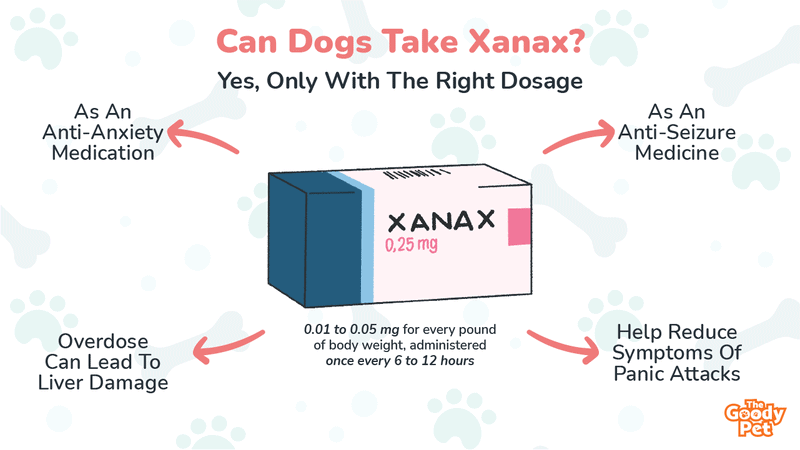Lately, you have noticed that the aggression level of your canine has dramatically increased. You feel so bothered about this. Then a close relative suggests you give Xanax to your dog to calm its nerves. You were taken aback, and you wondered: Can dogs take Xanax? Is it a good idea?
Yes, dogs can be given Xanax under close supervision by a qualified veterinarian. The medication is often used as an anti-anxiety or anti-seizure medication in dogs. Giving Xanax to your dog helps reduce symptoms of panic attacks that typically occur during thunderstorms and fireworks.
One of the common side effects of giving Xanax to your canine is pronounced sedation. To learn about other side effects of this medication on dogs, we urge you to keep reading this article. Before we discuss the side effects of Xanax on dogs, let’s talk about how safe it is to give Xanax to your dog.
Is Xanax Safe For My Dog?

Xanax is safe for dogs to use. This anti-anxiety medication works by altering some parts of the brain to produce the desired outcome.
Xanax is also used in treating some painful muscle conditions in dogs. If your canine is having a sore muscle after an intense exercise, Xanax could be prescribed by a vet to relieve the pain.
If your dog has not been eating well, veterinarians often prescribe Xanax to increase the appetite of dogs. If your dog is depressed, it is the go-to medication for vets.
We only recommend giving your canine Xanax under the supervision of a veterinarian. Xanax overdose can potentially lead to liver damage.
Is Xanax Safe For Older Dogs?
It depends. Xanax should be used with caution in dogs that are debilitated or geriatric; this medication can significantly affect their abilities.
Before giving Xanax to an older dog, consult with your veterinarian. The senses of older dogs are dull compared to their younger counterparts. Xanax should be given to them under close supervision.
An older dog will likely find it difficult to fully metabolize Xanax due to reduced liver and kidney functions.
Do not give Xanax to an older lactating dog. The medication easily crosses into the milk of a nursing dog. The breast milk would then sedate the young puppies.
Can I Give My Dog Human Anxiety Medication?
Human medications are not always safe for pets. Ask your veterinarian before giving any human medication to your pet.
Xanax happens to be part of human anxiety medication that is safe for pets to use. You should never attempt to estimate dosing from humans to pets.
Every dog is unique; Some breeds of dogs can tolerate some medications better than other breeds. Always make sure to get specific pet medicine instructions from your vet.
How Long Does Xanax Last In Dogs’ System?
Xanax lasts for about 24 hours in dogs. But the effect lasts much longer in dogs with liver or kidney disease.
When Xanax is given to dogs, the effect is manifested within 1 to 2 hours after ingestion. After giving your dog Xanax for the first time, monitor your canine for adverse reactions.
If you notice any adverse reactions, take your canine to the emergency treatment room without delay!
What Happens If A Dog Takes Xanax?

A dog feels relaxed and calm after taking Xanax in the proper dosage. An overdose of this medication can lead to severe cardiac and respiratory problems for your dog.
Xanax toxicity can either be mild or severe, depending on the level of overdose. The symptoms of mild toxicity in dogs include the following:
- Sedation
- Incoordination
- Nausea
- Agitation
While the symptoms of severe Xanax toxicity include the following:
- Vomiting
- Hypothermia
- Respiratory depression
- Cardiac depression
If you notice any of the above symptoms in your dog, take your canine to the emergency room immediately.
The vet will run a blood test and urinalysis to confirm Xanax’s toxicity in your dog. Depending on the level of toxicity, your dog may only need supportive treatment.
How Does Xanax Affect Dogs?
Xanax causes dogs to become slightly sedated and ataxic for a few days. Other symptoms you will observe can include vomiting and diarrhea.
Xanax interacts with other medications. Avoid giving medications such as antacids and vitamin supplements before Xanax administration.
Long-term use of Xanax can cause withdrawal symptoms in your dog. Your canine can also become easily addicted to it. Speak to your vet about the long-term use of Xanax.
Can Xanax Help An Aggressive Dog?
Yes, Xanax is renowned for calming aggressive dogs, and it has been in use since the early 1990s.
Xanax also has a history of being well-tolerated by dogs of various breeds. If your dog is on long-term use of Xanax, yearly blood work is recommended.
The blood work will reveal how well your dog’s kidneys and liver are metabolizing the medication.
One of the unpalatable side effects of Xanax that many dog owners don’t like is extreme sedation and lethargy.
Newer medications like Prozac do not have these effects at all. The goal is to calm dogs, not to sedate them.
How Do I Know If My Dog Needs Anxiety Medication?
Sudden unexplained aggression and extreme fear of being left alone are typical signs that your dog needs anxiety medication.
Dogs’ emotions are complex, and we often struggle to understand what our canines are going through. Some dogs struggle to cope with the stress of everyday life.
To cope with the stress of everyday life, some dogs resort to snarling and lunging at every stranger or dog that walks by.
You should remember that medication is not the solution to every problem of your dog. For your dog to be well behaved, you must socialize it through proper training.
How Do I Give My Dog Xanax?
Xanax is given by mouth in the form of a tablet or liquid solution. Give this medication 30 to 60 minutes before the triggering event, with or without food.
If your canine vomits the first time you give it Xanax on an empty stomach, make sure you give the next dose with food.
If you miss a dose, give it immediately when you remember. If the missed dose is close to the next one, skip the missed dose and give the next dose when due.
Never should you attempt giving two doses to your canine at once. Always keep an eye on your canine after administering Xanax to your dog.
How Many Milligrams Of Xanax Can A Dog Have?
Normally, the typical dose of Xanax for dogs is between 0.01 mg to 0.05 mg per pound of body weight once every 6 to 12 hours as needed.
The weight of your dog would most times determine the dosage of Xanax it will receive. If you have a large breed of dog, it would require a higher dose of Xanax.
If the anxiety issue of your canine is severe, your vet will opt to prescribe a higher dose of Xanax for your canine.
Xanax is available in tablet form, and you can give it to your canine with or without food. If your canine is a puppy, your vet will likely give the liquid form to it for easy dosing.

How Do I Wean My Dog Off Xanax?
The general recommendations for Xanax withdrawal are to taper the dosage by approximately 5% to 10% weekly or fortnightly.
Just like in humans, withdrawing completely from Xanax is problematic for dogs that are Xanax-dependent.
If your dog has been Xanax-dependent for a long time, it becomes dangerous to abruptly stop giving your canine altogether.
The key to weaning your dog off Xanax is to gradually reduce the dose weekly or bi-weekly.
Reducing the dosage form of Xanax is thought to be difficult. This is because the pills are small, making it hard to reduce the dosage.
Another solution for weaning off your dog from Xanax is to switch to a long-lasting medication like Valium.
How Do I Store Xanax?
Store it in a dry place at room temperature, which is about 68 °F to 77 °F. Do not store Xanax somewhere moist, as moisture can cause the medication to break down sooner.
The proper storage of Xanax helps ensure that the drug will remain effective until its expiration date. And make sure to keep the medication out of direct sunlight and out of reach of pets and children.





